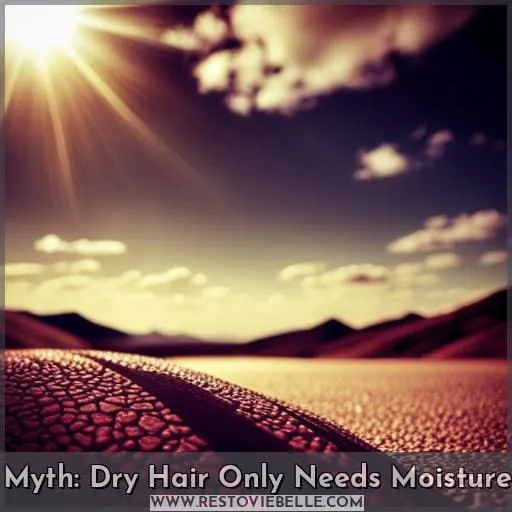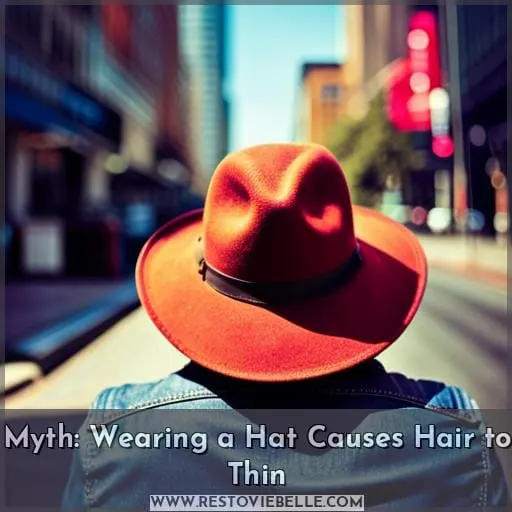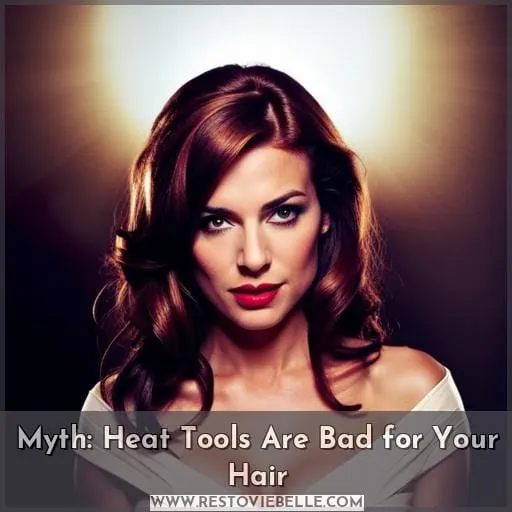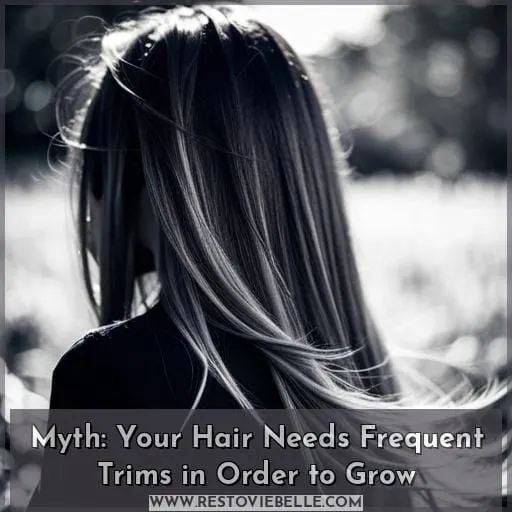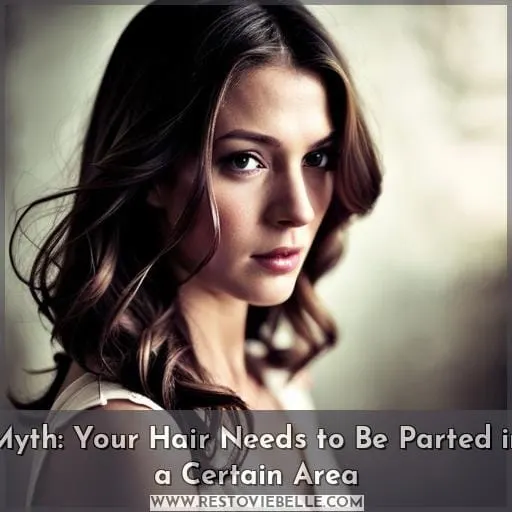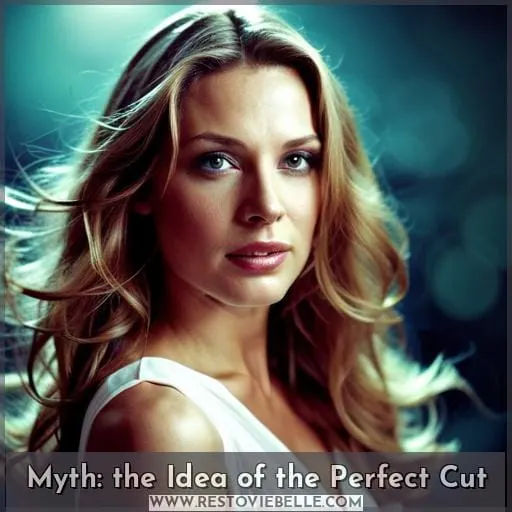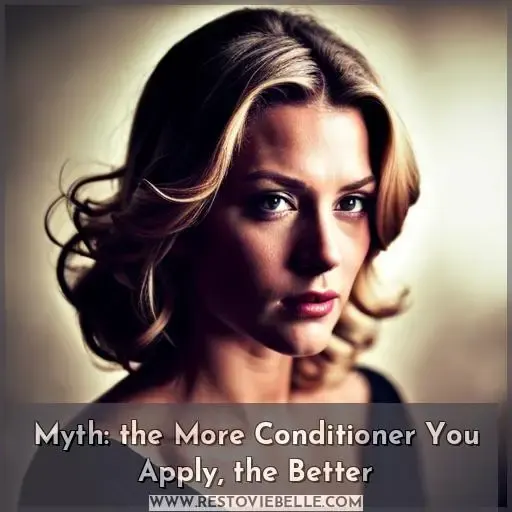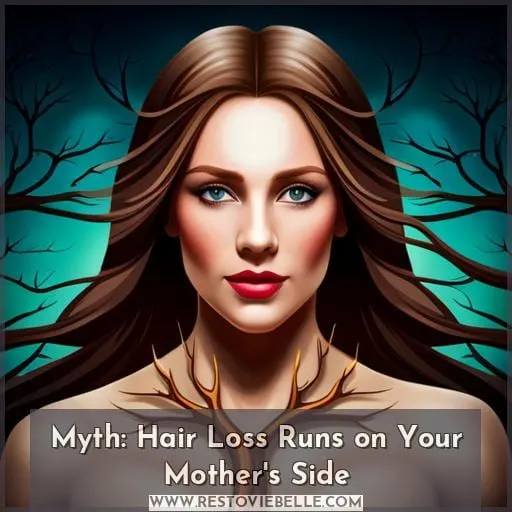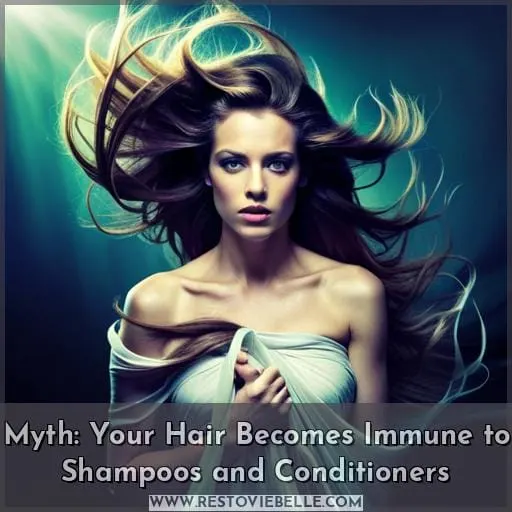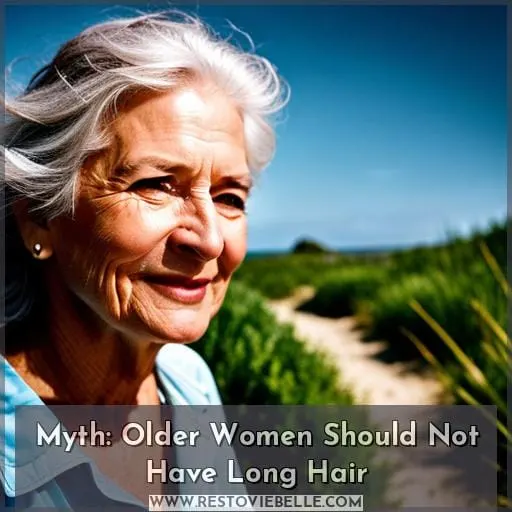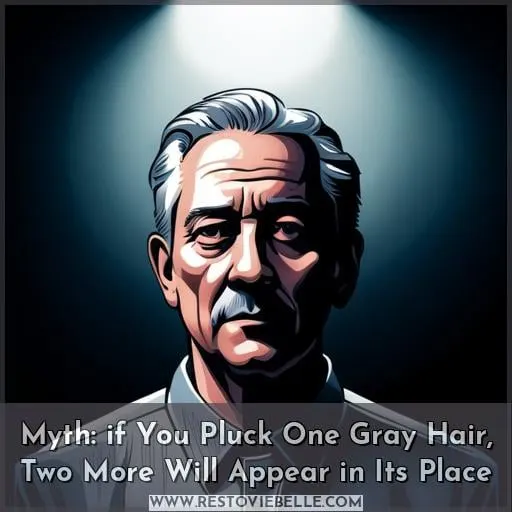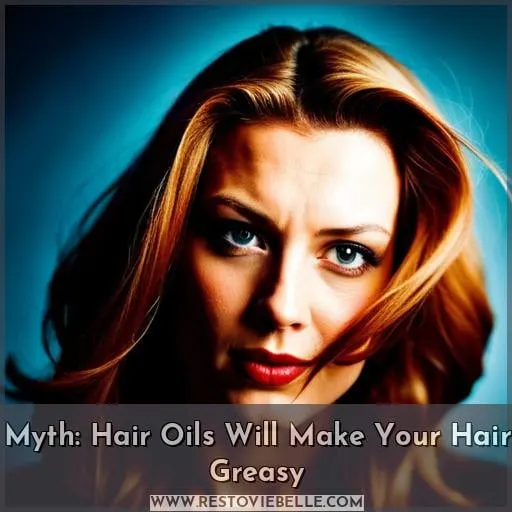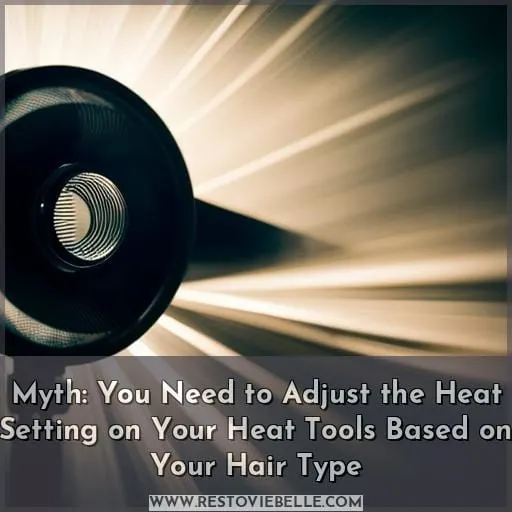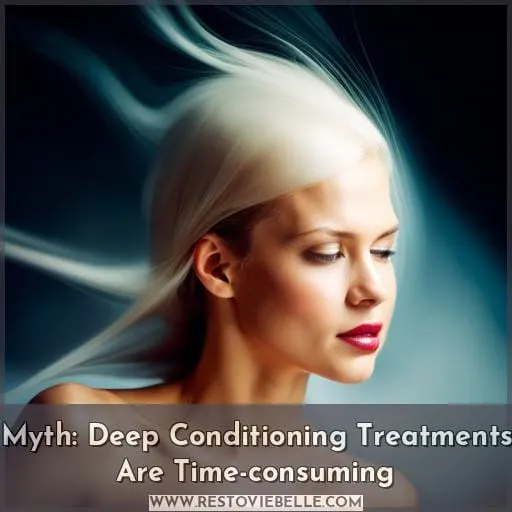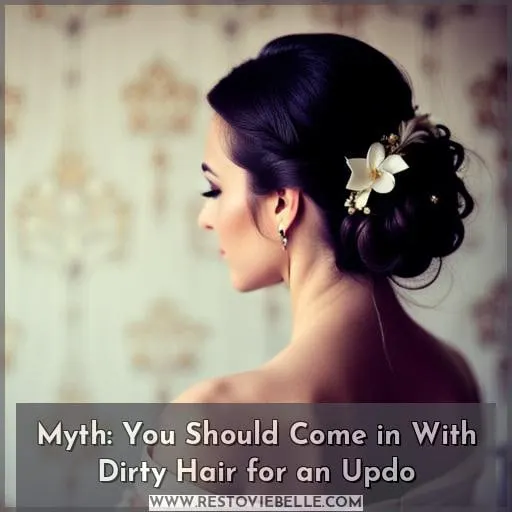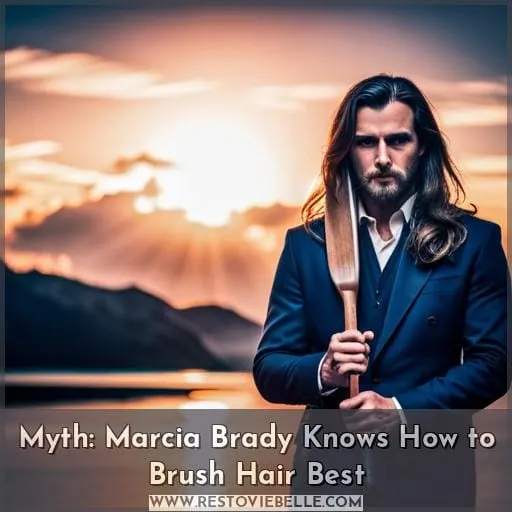This site is supported by our readers. We may earn a commission, at no cost to you, if you purchase through links.
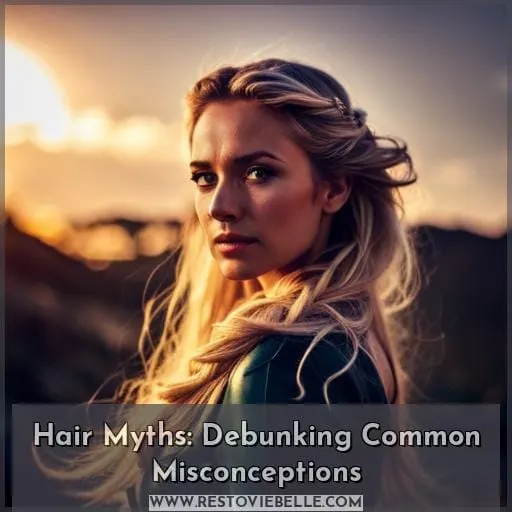 Are you tired of hearing the same old hair myths over and over again? Have you ever wondered which ones are true and which ones aren’t? From dryness to thinning, heat tools to frequent trims – there’s a lot of misinformation out there when it comes to hair care.
Are you tired of hearing the same old hair myths over and over again? Have you ever wondered which ones are true and which ones aren’t? From dryness to thinning, heat tools to frequent trims – there’s a lot of misinformation out there when it comes to hair care.
From wearing hats causing your hair to thin or the belief that you need frequent trims in order to grow, many people have been believing these age-old tales about taking care of their tresses for far too long.
It turns out that most of them simply aren’t true when it comes down to maintaining healthy, beautiful-looking locks.
So keep reading if you want the real scoop on caring for your mane without getting caught up in any more myths about hair!
Table Of Contents
- Key Takeaways
- Myth: Dry Hair Only Needs Moisture
- Myth: Wearing a Hat Causes Hair to Thin
- Myth: Heat Tools Are Bad for Your Hair
- Myth: Your Hair Needs Frequent Trims in Order to Grow
- Myth: Your Hair Needs to Be Parted in a Certain Area
- Myth: the Idea of the Perfect Cut
- Myth: the More Conditioner You Apply, the Better
- Myth: Hair Loss Runs on Your Mother’s Side
- Myth: Your Hair Becomes Immune to Shampoos and Conditioners
- Myth: Older Women Should Not Have Long Hair
- Myth: if You Pluck One Gray Hair, Two More Will Appear in Its Place
- Myth: Hair Oils Will Make Your Hair Greasy
- Myth: You Need to Adjust the Heat Setting on Your Heat Tools Based on Your Hair Type
- Myth: Deep Conditioning Treatments Are Time-consuming
- Myth: You Should Come in With Dirty Hair for an Updo
- Myth: Keratin is Always a Good Idea
- Myth: Marcia Brady Knows How to Brush Hair Best
- Conclusion
Key Takeaways
- Dry hair needs moisture, but excess water can weaken it.
- Wearing hats doesn’t cause hair thinning; it protects from the elements.
- Frequent trims aren’t necessary for hair growth; regular maintenance helps.
- Hair loss is influenced by both parents, not just the mother’s side.
Myth: Dry Hair Only Needs Moisture
You should not neglect moisture for dry hair; regular use of conditioners and leave-in treatments can help prevent cuticle damage, frizz, breakage, and brittle strands. However, is excessive moisture bad for the hair? The answer is yes – too much water or other liquids can cause swelling in the cortex of the strand, weakening it.
Properly moisturizing dry hair requires finding a balance between adding enough liquid without overdoing it. Oils play an important role in this process since they can keep both the scalp and strands hydrated while sealing in the necessary moisture.
Instead of constantly applying liquid products every day, like some people do with plain water alone, using oils can be more beneficial in the long run.
Ignoring oils altogether can make pre-existing issues worse. Therefore, it’s best to include them in your hair care routine along with other products. Additionally, there are alternative solutions available, such as using steamers, hot compression towels, and deep conditioning natural masks.
However, it’s important to use these methods wisely and understand the common causes behind dry hair before trying anything else.
Myth: Wearing a Hat Causes Hair to Thin
Though it’s often believed that wearing a hat can cause hair to thin, the truth of the matter is that genetics and hormonal imbalances are usually to blame. Not only does wearing a hat not cause your hair to thin, but it can actually protect your locks from environmental factors like sun exposure or windy days.
Hats come in various styles and accessories such as beanies, baseball caps, fedoras, floppy hats – all of which look great and add an extra layer of protection for your head while enhancing any outfit.
When selecting a type of hat or style, you should take into account how much coverage you need depending on weather conditions outside. Thick fabric provides more insulation against cold climates, whereas lightweight fabrics are better for hot climates since they won’t make you sweat underneath them during summer months.
Additionally, when taking care of hats, be sure to read labels so that you know what material requires specific cleaning instructions such as hand-washing versus machine washing. Improper care could lead to damage down the line, either by discoloration or tearing apart at seams due to its fragility caused by water soaking through delicate materials over time.
It also helps if proper maintenance routines become part of your habit, including brushing off excess dirt with a lint brush after each wear, which prevents buildup on fabric and potential fungal growth over time.
While fashion may dictate trends in regards to certain types of hats this season, having knowledge about protecting yourself from potential health risks associated with ill-fitting ones makes perfect sense, especially when looking out for your own personal welfare overall in the long term.
Myth: Heat Tools Are Bad for Your Hair
It’s a common misconception that heat tools are bad for your hair, but this isn’t always the case! When used correctly and in moderation, heat styling can be beneficial for your hair.
Here are some tips to help you use them safely without causing any damage:
- First off, make sure you’re using the right type of tool with the correct temperature setting.
- Secondly, invest in good quality heat protectant products before styling to minimize potential harm from exposure to high temperatures.
- Thirdly, try out different techniques like blow-drying at a lower level or diffusing instead of straightening or curling.
- Finally, look into other ways such as braiding or air drying which provide an equally gorgeous outcome but without excessive amounts of heat being applied directly onto vulnerable locks.
Myth: Your Hair Needs Frequent Trims in Order to Grow
Contrary to popular belief, frequent trims are not essential for hair growth. According to experts, hair grows a quarter-inch per month regardless of ethnicity or texture. Trimming the ends of your locks can improve its overall health and appearance by removing split ends and helping prevent future breakage.
Regularly trimming away damaged tips will help keep it strong as opposed to longer strands that may be more prone to damage from styling products or environmental factors like sun exposure. Split ends cause frizziness, which makes it harder for oil produced at the scalp to travel down each strand, resulting in dryness due to lack of moisture.
It is important, however, not just to focus on length when deciding whether or not you should get a trim. If your locks look dull and have visible splits throughout instead of only at the very end, then chances are they need some attention! A good rule of thumb is getting your tresses trimmed every 6-8 weeks, depending on what type of style you prefer.
Shorter cuts require more frequent trips, while those with long manes can usually wait a bit longer between appointments without noticing much difference in their appearance since the growth rate remains steady no matter how often you cut off dead ends.
Myth: Your Hair Needs to Be Parted in a Certain Area
You don’t need to part your hair in a certain area for it to grow healthy and strong. With different partings, styling options are endless! It all depends on what will best suit the face shape, as well as your hair texture and volume.
If you have thick or curly hair that tends to be unruly, then try parting it down the middle with an even division of both sides; this will create balance when styled. For fine or straight strands that lack body, sweeping layers back away from the forehead can give more dimension while creating a flattering silhouette around the face.
When deciding which way you should wear your locks parted each day, keep in mind how often you wash and condition them too. If not regularly enough, dirt buildup can occur at one side, making any other style appear uneven and lopsided due to weight distribution issues caused by product residue along with natural oils produced by scalp glands which aren’t being washed away completely during the cleansing process.
The key is finding what works best for individual needs, whether it’s trying out new cuts, experimenting with different types of products, or playing up natural hair textures. There’s no single right answer as far as where exactly should we always place our parts, but instead taking into account factors like facial features, age group, etc.
Myth: the Idea of the Perfect Cut
Forget the idea of a perfect cut, because every head of hair is unique and requires different styling techniques. There are countless haircut trends to choose from, and it can be difficult to decide which one works best for you.
When selecting a style or length for your hair type, consider cultural norms as well as personal preference. Don’t forget about face shape either; certain hairstyles may not flatter yours like others will.
Before attempting any DIY haircuts, make sure you have all the necessary tools on hand, such as scissors, clippers, and combs, along with tutorials or videos if needed.
To ensure you select the right look, match your haircut personality – think natural texture versus straightening processes when deciding how often to trim split ends or what products should be used on oily hair types versus dry ones prone to frizzing up quickly.
Myth: the More Conditioner You Apply, the Better
When it comes to conditioning your hair, there are many myths that can lead you astray. It’s easy to think that the more conditioner you apply, the better; however, this isn’t always true. Applying too much conditioner can actually weigh down your hair and make it appear greasy or limp.
Instead of applying a lot of product all over your scalp and strands, focus on using just enough so as not to overwhelm them with heavy ingredients.
- Start at mid-shaft and work towards ends. Conditioning from the roots will cause oils to accumulate near the scalp, which could result in dullness or frizziness later on.
- Use separate products for detangling. A leave-in is best used after showering since its purpose is not necessarily moisturizing but rather detangling wet locks quickly without breakage or damage while adding body and shine as well.
- Invest in quality products. Quality haircare items contain higher concentrations of nurturing ingredients such as essential oils instead of fillers like waxes or silicones, which may clog pores when applied heavily onto already fragile strands!
By following these simple steps, you’ll be able to take care of your tresses properly while overcoming any false notions around proper application techniques when using a good quality conditioner tailored specifically for individual needs—scalp health being primary among them!
Myth: Hair Loss Runs on Your Mother’s Side
Contrary to popular belief, hair loss is actually influenced by both parents rather than solely your mother’s side. It’s true that family history can be a key indicator of genetic factors in the development of certain conditions, such as hair loss.
However, it’s important to note that genetics are not exclusive and often interact with other factors like hormonal influence or environmental triggers when determining an individual’s risk for developing specific conditions.
Although there may be some indication from family history regarding one’s propensity for hair loss due to paternal genes, many individuals experience thinning without any clear link from their lineage.
In fact, even if you have a strong family history of baldness on your father’s side, it doesn’t guarantee you will experience it as well.
Hair genetics are complex and involve multiple layers, which makes understanding the risks associated with this condition difficult. However, debunking myths about its causes helps us better understand our own risk level, so we can make informed decisions about our healthcare needs accordingly.
Myth: Your Hair Becomes Immune to Shampoos and Conditioners
Don’t believe the myth that your hair becomes immune to shampoos and conditioners, as regularly switching up products can help keep locks looking healthy and luscious. The effectiveness of ingredients in shampoos and conditioners may be impacted by environmental factors like humidity or heat, so considering these elements when choosing a product is important.
To get the best results for your individual hair texture, it’s recommended to create a personalized haircare routine. This routine should include frequent shampooing with specialized products tailored towards your specific needs.
Scalp health also plays an important role in enhancing the shine, strength, and elasticity of your strands. You can use natural oils on the mid-lengths and ends of your hair for added nourishment.
Common misconceptions about washing frequency should also be addressed. Daily shampooing doesn’t always cause scalp dryness or lead to overproduction of oils if done correctly.
Myth: Older Women Should Not Have Long Hair
Despite age, long hair can be stunningly lustrous if taken care of properly. It’s a common misconception that older women should not have long hair.
Long locks create an air of elegance while allowing you to play with different styling options such as braids or updos.
Hair myths about length abound. Some say that cut trims promote growth, but it’s really good scalp health that helps your hair reach its full potential. Another myth suggests washing every day keeps your mane looking fresh, but just like skin needs time between moisturizing sessions, shampooing once or twice a week allows natural oils to nourish strands without stripping them down completely.
So don’t let outdated standards dictate how you wear your tresses – embrace any changes and make sure you’re taking proper care when styling any length at any stage in life!
Myth: if You Pluck One Gray Hair, Two More Will Appear in Its Place
Are you worried that plucking one gray hair will lead to two more? Many people believe it, but this is a myth.
Gray hair is caused by genetics, not stress or plucking individual strands of hair. As we age, our body produces less melanin, which leads to the graying of our hairs over time.
The best way to care for your grey locks is with gentle products such as sulfate-free shampoos and conditioners designed specifically for silvering strands.
If you’re looking for extra sparkle, try using heat protectants when styling curls or straightening tresses.
Myth: Hair Oils Will Make Your Hair Greasy
Be mindful that while hair oils can add shine and moisture retention to your locks, overusing them on oily hair may leave a sticky residue. Hair-related myths are tricky to navigate as there is often conflicting information.
When it comes to natural oils for hair, it’s important to understand the pros and cons of using them so you can choose wisely when it comes time for styling or conditioning treatments.
Those with naturally oily scalps should limit their application of oil onto the strands only, as any extra product will weigh down dirty hair and create an unwanted greasy look. However, those who have dry scalp issues like dandruff or eczema could benefit from adding a few drops of oil into their weekly routine in order to help balance out the scalp’s natural oil production levels which could lead towards healthier looking locks overall.
It is also worth noting that people with different ethnicities might require varying amounts depending on how much sebum they produce naturally throughout each day.
By understanding how best practices work together in unison regarding balancing oiliness versus nourishing dehydrated strands, we can overcome misconceptions about what types of products work well within our individual haircare routines, allowing us to observe optimum results without compromising quality health standards.
Myth: You Need to Adjust the Heat Setting on Your Heat Tools Based on Your Hair Type
It’s important to adjust the heat settings on your heat tools based on your hair type for optimal styling without damaging it.
- Check the temperature: Heat protectant products don’t make blow-drying completely safe, so use a lower setting and minimize exposure. Most irons should be set at 365 degrees Fahrenheit for all hair types, but coarser textures may require lower temperatures while finer textures may need higher ones.
- Find what works best: Experiment with different levels of heat until you find one that suits your specific needs – remember, not all tools are created equal! If you’re using curling or flat irons regularly, opt for ceramic or tourmaline plates to reduce damage from high temperatures by distributing the heat evenly throughout each strand of hair as well as protecting against frizz and flyaways caused by static electricity buildup in strands when dried too quickly with other materials like metal plates.
- Keep an eye out: Monitor how much time is spent applying direct heated air onto any given section of your head; this will help ensure that no part gets over-exposed or burned due to prolonged contact between tool plate/barrels/attachments and scalp/hair shafts alike! Keep in mind also that some hairstyles can take longer than others depending on desired outcome – practice makes perfect here too! By adjusting the temperature accordingly based on texture, length, thickness, and style goal, you’ll have beautiful locks every time without worrying about unnecessary tress stress (heat damage)!
Myth: Deep Conditioning Treatments Are Time-consuming
Take just a few minutes to enjoy the benefits of deep conditioning treatments! Contrary to what some might think, these treatments don’t need to take hours out of your day. In fact, there are quick and efficient ways you can condition your hair without compromising results.
With alternative methods like pre-shampoo treatment oils or overnight masks, you can get all the nourishment and hydration that comes with deeper conditioning in less time than expected. You’ll want to find an effective product that works for your specific hair type.
If possible, look for one with natural ingredients such as honey or avocado oil, which will help moisturize and strengthen damaged strands while also providing shine.
When using products, be sure not to apply too much as this could weigh down fine hairs, making them flat and limp instead of bouncy voluminous tresses! A good rule is to only coat from mid-lengths down towards ends, avoiding the scalp area altogether unless it’s particularly dry or flaky.
Once applied, cover your head with a plastic cap, allowing the heat from steam/warmth created by body temperature to activate active ingredients, helping them penetrate into the cuticle layers faster. This results in a quicker treatment time, usually between 10 – 30 mins max, depending on the desired result.
For more intense treatments, longer periods may be required, but never exceed 45 minutes at any given time, no matter how damaged your locks may be.
Finally, when finished rinsing after a lukewarm rinse, follow up with a cold water sealer to ensure maximum softness, smoothness, and a shiny finish before styling away.
Myth: You Should Come in With Dirty Hair for an Updo
Contrary to popular belief, you should come in with freshly shampooed hair for an updo to achieve the best look.
- Use a clarifying shampoo once a week and regular moisturizing or hydrating shampoos between washes.
- Blow-dry on low heat settings. Too much heat can cause damage and breakage over time.
- Always use conditioner after washing, as it helps seal moisture into the strands. This is especially important if you’re blow-drying instead of air drying your hair before styling it into an updo style.
- Detangle wet hair gently with a wide tooth comb before applying any leave-in conditioners or other products that add body, strength, and shine.
- Make sure all knots have been brushed out prior to beginning the stylist’s work. Otherwise, extra tension could be placed on certain sections, causing strain and potential breakage during the styling process.
By following these simple steps, you’ll ensure that your locks are well hydrated when styled into an updo, making them more resilient against damage from tight hairstyles like braids or ponytails often seen in modern-day styles.
Myth: Keratin is Always a Good Idea
Using too much keratin can make your hair rigid and brittle, so it’s important to apply only what you need for the desired effect. For example, if you’re looking for a sleek finish without sacrificing volume, opt for a light application of keratin.
To get the most out of this treatment, understand both its pros and cons as well as misconceptions that come along with it.
Keratin treatments are known to reduce frizz in dry or damaged hair while also maintaining moisture levels by creating a protective barrier from environmental damage like sun exposure or cold weather conditions.
On the other hand, there is still potential risk associated with over-applying keratin such as breakage due to being overly stiff and brittle after application. However, using an appropriate amount will provide smoothness while adding shine without compromising texture or causing any harm.
There are alternatives available when seeking similar benefits, such as leave-in conditioners, which provide deep moisturizing effects but may lack long-lasting results compared to professional salon treatments containing high concentrations of formaldehyde-free formulas specifically designed not just for masking frizz but repairing underlying damage caused by heat styling tools and chemical processes alike!
In short, understanding how to use products containing these key ingredients properly will help ensure maximum results while avoiding unnecessary risks. This makes them versatile solutions aiding all types of hairstyle choices regardless of age, ethnicity, gender, or hair type.
Myth: Marcia Brady Knows How to Brush Hair Best
You’ve probably heard the classic advice to brush your hair 100 times a day from Marcia Brady, but is this really the best way to care for your locks?
From Leven Rose Jojoba Oil and Miss Jessie’s Curls Cream to Flex Brush XL Boar Nylon and Grace Eleyae Sleep Cap Black, there are plenty of products available that can help you maintain healthy hair.
Not only do they provide moisture retention with ingredients like argan oil or biotin protein, but they also offer tools like HEETA Scalp Massager Brushes and KareCo Tangle Buster Combs that make it easier than ever before.
Leven Rose Jojoba Oil
Try Leven Rose Jojoba Oil for a light, silky, and nourishing experience! Its versatile uses include skin nourishment, acne treatment, hair hydration, and more.
- Moisturizes and strengthens hair
- Replenishes natural oils stripped away by soaps and shampoos
- Provides shine, body, and strength to hair
- Enriches visibly radiant skin with no additives or parabens.
Miss Jessies Curls Cream
You’ll love Miss Jessie’s Curls Cream for its luscious locks and lasting hydration. It fights frizz, provides uniformity, and helps manage multicultural hair types. The perfect balance of weight hydrates without leaving a sticky residue or stiff feel.
Flex Brush XL Boar Nylon
For the perfect blow-dry, give your hair some TLC with the Flex Brush XL Boar Nylon. Soft boar and nylon bristles gently detangle without snags or damage for all hair types.
Grace Eleyae Sleep Cap Black
Slip on the Grace Eleyae Sleep Cap Black for a stylish and comfortable way to lock in moisture, benefit from the satin fabric benefits, and protect your hair from heat damage while you sleep – creating an ideal hair routine.
Curiously Clarifying Lemongrass Conditioner
Try Acure Organics’ Curiously Clarifying Lemongrass Conditioner! Argan oil replenishes, while lemongrass clarifies. It is vegan-certified and free of harsh chemicals. Suitable for keratin-treated hair, all types, and styles.
The pleasant fragrance won’t overpower and eliminates the need to brush post-showering.
HEETA Scalp Massager Brush
Experience the therapeutic benefits of the HEETA Scalp Massager Brush, which features soft silicone bristles and an ergonomic design to help reduce dandruff and promote a healthier scalp. The brush massages your scalp for relaxation techniques, exfoliates for hair growth stimulation, and increases blood flow for improved overall health.
Achieve perfect hairstyles for women over 40 and shampoo oily hair with luscious locks! Thermal stress is minimized by this handy tool’s anti-slip grip, making it a must-have product.
Biotin Hair Thickening Spray
Give your hair an extra boost with Biotin Hair Thickening Spray, which blocks the DHT hormone and prevents hair loss. Benefits include a voluminous look, no residue or buildup, and a lightweight formula.
Usage tips: apply to damp hair for an instant texturized style; use as a pre-styler for layered texture. Reviews rave about its effectiveness; alternative products such as weaves and wigs are also available through beauty specialists.
Redken Diamond Oil Glow
Discover the Redken Diamond Oil Glow for a boosted blow-dry and mirror-like shine that will make your hair look amazing! Enjoy protection from heat, taming of frizz and flyaways, plus its liquid texture won’t weigh down your strands.
With benefits like these – plus no greasiness or stickiness – it’s easy to see why so many love this product: Hair oil benefits, Styling with oils, Heat protection tips, Hair growth myths & more! Plus save time drying while nourishing locks with silky softness.
KareCo Tangle Buster Comb
Try the KareCo Tangle Buster Comb for easy glide combing teeth, perfect for detangling all hair types without snagging or tangling – just like a kid in a candy store! The non-slip grip and wide tooth design make it ideal for young children, deep conditioning, and color application.
Conclusion
It’s time to bust some of the myths surrounding hair care. From the idea that heat tools are bad for your hair to the misconception that grey hair is caused by stress, it’s important to understand the facts so you can make informed decisions about your hair care routine.
For instance, contrary to popular belief, plucking one grey hair won’t cause two more to appear in its place. And while deep conditioning treatments can be time-consuming, they are essential for healthy and hydrated hair.
With the right tools and knowledge, you can achieve your desired look while also taking care of your hair.
